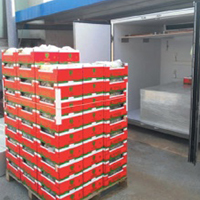Shipping container equipped with controlled atmosphere: Case study on table grape

All claims expressed in this article are solely those of the authors and do not necessarily represent those of their affiliated organizations, or those of the publisher, the editors and the reviewers. Any product that may be evaluated in this article or claim that may be made by its manufacturer is not guaranteed or endorsed by the publisher.
Authors
A prototype of shipping container equipped with controlled atmosphere (CA) system (CA-prototype), was used for the simulation of the cold transport of table grapes (cv Italia). The CAprototype was realised by IFAC SPA, within the Research Project Continnova. It is equipped with a cooling system in order to work at a temperature between –20°C and +15°C. The CA management is realised through the control system and the connections with the remote application. The experimental simulation of the cold transport was realised putting 20 boxes of table grapes inside the CA-prototype (set at 20% O2 + 10% CO2 in nitrogen), other 20 in a refrigerated room using a SO2 pad inside each box, the remaining 20 in a cold room (Control) without SO2 pad for 12 days at 5°C. At the end of the simulated transport, for each postharvest solution, 10 table grapes boxes were analysed, while the remaining 10 were stored for 3 days at 20°C in air with the aim to simulate a shelf-life period. CA-prototype allows preserving table grapes visual quality, delaying browning and maintaining berry turgidity, extending the shelf-life until 12 days at 5°C. Finally, CA-prototype resulted a valid alternative to the commonly used SO2 pads, which are under constant revision because of its potential allergenic effects.














